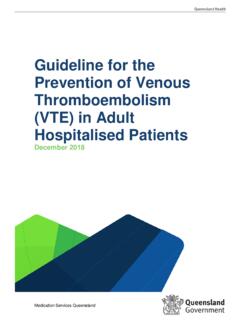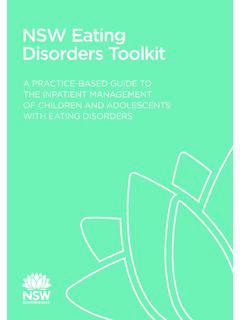Transcription of The Administration of Electroconvulsive Therapy
1 Guideline The Administration of Electroconvulsive Therapy September 2018 The Administration of Electroconvulsive Therapy - ii - Guideline for the Administration of Electroconvulsive Therapy Published by the State of Queensland (Queensland Health), September 2018 This document is licensed under a Creative Commons Attribution Australia licence. To view a copy of this licence, visit State of Queensland (Queensland Health) 2018 You are free to copy, communicate and adapt the work, as long as you attribute the State of Queensland (Queensland Health).
2 For more information contact: Mental Health Alcohol and Other Drugs Branch, Department of Health, GPO Box 48, Brisbane QLD 4001, email phone (07) 332 89374. An electronic version of this document is available at Disclaimer: The content presented in this publication is distributed by the Queensland Government as an information source only. The State of Queensland makes no statements, representations or warranties about the accuracy, completeness or reliability of any information contained in this publication. The State of Queensland disclaims all responsibility and all liability (including without limitation for liability in negligence) for all expenses, losses, damages and costs you might incur as a result of the information being inaccurate or incomplete in any way, and for any reason reliance was placed on such information.
3 The content presented in this Guideline is recommended for use by Authorised Mental Health Services (AMHS) (both Public and Private) for the purpose of administering Electroconvulsive Therapy . It sets out guiding principles and recommendations that, in the view of Queensland Health, should be followed by the AMHSs in the Administration of ECT. Whilst this guideline makes every effort to be as comprehensive as possible, it does not cover every eventuality as the circumstances of treatment for individuals may differ. Psychiatrists and other health professionals are required to tailor treatments to individual patient needs.
4 This guideline is to be read in conjunction with the Chief Psychiatrist Practice Guidelines for Electroconvulsive Therapy The Administration of Electroconvulsive Therapy - iii - Contents 1. Purpose .. 1 2. Background .. 1 3. Scope .. 1 4. Related documents .. 1 Authorising Policies and Standards .. 1 Procedures, Guidelines and Protocols .. 2 Forms and templates .. 2 Terminology used in guiding documents .. 3 5. Governance of the ECT service .. 4 Role and membership of an ECT quality committee .. 4 Maintenance of equipment and supplies.
5 5 6. Staff training .. 5 Consultant psychiatrists .. 6 Trainees .. 6 Other medical officers .. 6 Nursing staff .. 6 7. ECT credentialing and scope of clinical practice .. 7 8. Consent and legal issues .. 8 ECT is a Regulated Treatment under the Mental Health Act 2016 .. 9 Mental Health Review Tribunal Approval .. 10 Emergency ECT .. 11 9. Indications for ECT .. 11 10. Risks of ECT .. 12 Non-cognitive risks of ECT .. 12 Cognitive risks of ECT .. 13 Adverse incident or critical event .. 14 11. ECT in special populations .. 15 Children and adolescents.
6 15 Pregnancy .. 15 The elderly .. 16 12. Cultural considerations .. 16 13. Medical considerations prior to ECT history, physical examination and baseline cognitive testing .. 16 Psychiatric examination .. 16 Extended assessment .. 16 16 Consultation with other specialists .. 17 Medications and ECT .. 17 Cardiac pacemakers .. 18 Implanted cardiac defibrillators .. 18 The Administration of Electroconvulsive Therapy - iv - Cochlear implants .. 18 14. Equipment and staffing .. 18 Location of ECT Administration .. 18 ECT equipment.
7 19 Anaesthetic and resuscitation equipment .. 19 Staffing of the ECT suite .. 19 15. The ECT procedure .. 20 Patient identification and procedure 20 During the procedure .. 21 Sign out before the patient leaves the ECT suite .. 22 16. Post ECT care .. 22 Recovery .. 22 Management of adverse effects .. 22 Post-ECT delirium .. 22 17. Treating electrodes .. 23 Electrode placement options .. 23 Electrode placement recommendations .. 24 Electrode placement 26 18. Dosage .. 27 Dosage increases during treatment .. 27 19. Pulse 28 20.
8 Frequency and spacing of treatments .. 28 21. Number of treatments .. 29 22. Determination of an adequate seizure .. 29 Criteria for re-stimulation .. 30 Prolonged seizures .. 30 23. Titration technique .. 31 24. Documentation .. 31 Clinical monitoring over the treatment course .. 32 ECT treatment record .. 32 Clinical record .. 33 Post-ECT follow up and monitoring .. 33 ECT register .. 33 25. Continuation (C ECT) and maintenance ECT (M ECT) defined and explained .. 34 26. Outpatient ECT .. 34 Indications for outpatient ECT .. 34 Care after outpatient ECT.
9 35 Approval and Implementation .. 36 Policy Custodian: .. 36 Responsible Executive Team Member: .. 36 Approving Officer: .. 36 The Administration of Electroconvulsive Therapy - v - Appendix 1 .. 37 ECT Competence Practical Technique Guide .. 37 Appendix 2 .. 39 Medications by class: Considerations/advice relevant to ECT practice .. 39 Appendix 3 .. 42 Clinically significant drug interactions37,38 .. 42 Appendix 4 .. 43 Glossary .. 43 Appendix 5 .. 45 References .. 45 Appendix 6 .. 48 Suggested reading .. 48 Figures Figure 1 Bilateral and unilateral placement.
10 26 Figure 2 Bi-frontal placement .. 26 The Administration of Electroconvulsive Therapy - 1 - 1. Purpose This Guideline provides recommendations regarding best practice for the Administration of Electroconvulsive Therapy (ECT). 2. Background ECT has been an important treatment in psychiatry since the 1930s. There has been increasing evidence demonstrating the effectiveness of ECT in the treatment of severe depressive illness. There is also evidence to support the use of ECT in the treatment of acute mania, catatonia and schizophrenia and as a long term maintenance treatment (M ECT) for the same indications as for acute treatment.










